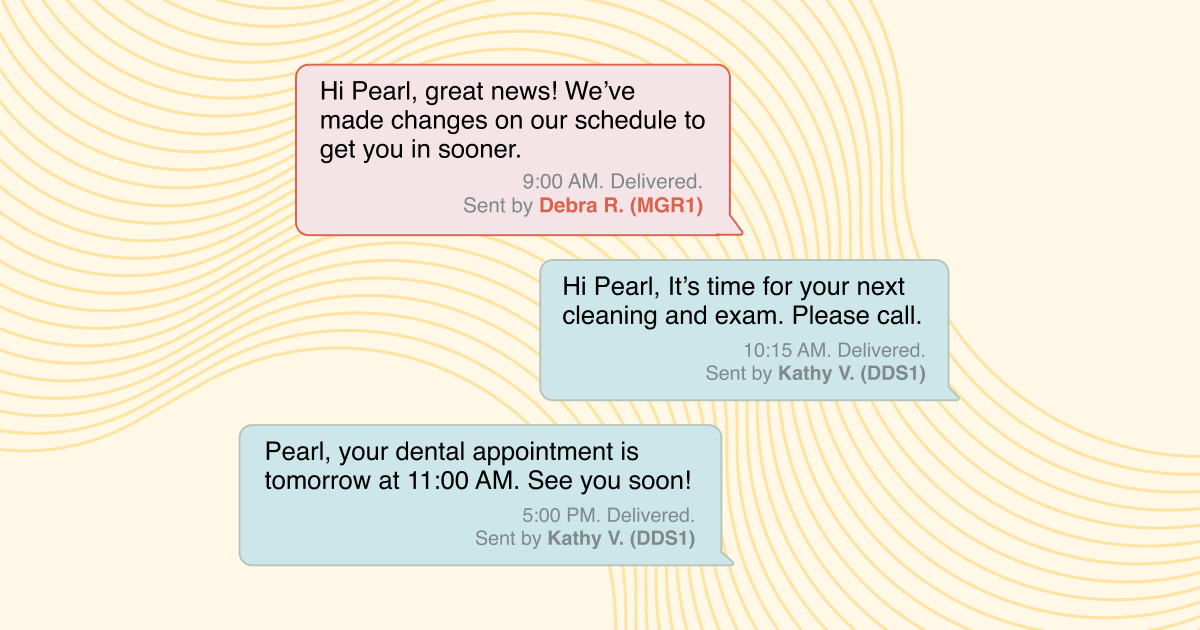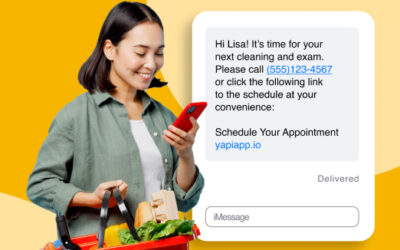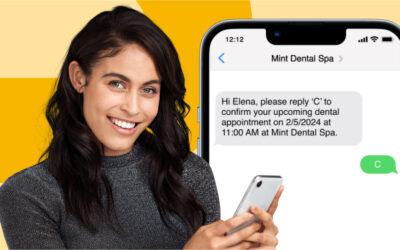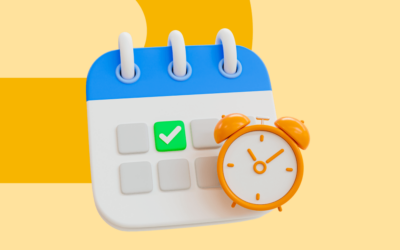
Dental offices must keep their appointment schedule running smoothly. Missed appointments can cause severe disruption to the workflow and impact the patient experience.
Broken appointments or no-shows also result in revenue losses for your dental practice. According to Ryan Long, DDS, one dental appointment cancellation or no-show per day may cost your practice a whopping $30,000 annually.
The simplest way to ensure your patients arrive on time is to send dental appointment reminders.
Dental practices can boost patient compliance, streamline operations, and better engage their patients by sending dental appointment reminders at the right frequency and with the right message.
You must ensure consistent dental appointment reminder frequencies to prevent such losses and effectively optimize your practice’s operations.
Each reminder must be personalized based on the scheduled dental procedure and the patient’s needs and preferences.
This article will discuss the ideal frequency for sending dental appointment reminders.
The Benefits of Sending Dental Appointment Text Reminders
Sending dental appointment reminders is an effective way for dental offices to provide patients with up-to-date information regarding their upcoming appointments.
It eliminates the hassles associated with missed appointments, such as rebooking, extra paperwork, and phone calls.
Dental practices can benefit by sending automated dental appointment reminders at appropriate frequency:
- Save time in making phone calls or sending paper-based reminders.
- Minimize the number of no-shows, resulting in better appointment management.
- Provide a convenient way for patients to confirm or reschedule their appointments.
- Eliminate the hassle of rebooking appointments and manually tracking them.
- Reduce time spent on administrative tasks related to missed and canceled appointments.
- Increase efficiency while also providing a more positive patient experience.
- Improve patient loyalty by helping them remember their scheduled visits.
What is the Ideal Frequency for Sending Dental Appointment Reminders?
Research published in the European Journal of Orthodontics suggests that each broken dental appointment could prolong the patient’s treatment duration by a month.
But on the other hand, it also results in significant monetary and productivity losses for the dental clinic.
Therefore, dental offices must ensure patients turn in on time for their treatment.
In addition, dental practices must send dental appointment reminders to all patients to ensure adherence to the treatment schedule.
79.5% of dental patients prefer digital methods for receiving dental appointment reminders over conventional ones.
Text (30%) and email (28%) have proven to be the most favored methods for dental appointment reminders. However, the frequency of sending dental appointment reminders depends on your patient base.
Text reminders are an excellent way of ensuring that a patient remembers their upcoming visit, as texts are often opened more quickly than emails and can be sent multiple times closer to the day of the appointment.
For example, it may be beneficial to send text messages within 24 hours before the scheduled visit and another one even one hour before.
Email reminders should also be well-timed to ensure the patient gets enough time to read them. They can include information such as contact details, directions to your office, or any other pertinent health-related information.
Additionally, emails could be sent out at least one week before the scheduled visit to give patients enough time to read and respond to the reminder.
Right Frequency to Send Dental Appointment Reminders
An effective dental appointment reminder system ensures the right frequency of patient communication.
Depending on the patient’s oral health, treatment, preferences, or any other potential variables, you must adjust the timing of appointment reminders.
The most appropriate frequency to send dental appointment reminders is:
Three Weeks
Patient reminders must be sent three weeks before the appointment date. It suits patients undergoing more intensive dental treatments like root canals or implants.
An early reminder allows the patient enough time to make any necessary changes in their schedule or reschedule their dental appointment with enough notice for your office to manage.
It helps increase the efficiency of your dental clinic and minimizes the chances of no-shows. You can also prepare for the treatment in advance upon receiving patient confirmation. For example, you can order the necessary equipment and materials for treatment or request specific health records or documentation from the patient.
Two Weeks
Reminding your patient of their upcoming appointment two weeks before the visit date is essential. It ensures they can plan the visit, preventing unnecessary delays. If patients cannot confirm the visit, they can reschedule it for a more convenient time.
Sending a reminder two weeks before gives you enough time to make arrangements for the treatment. You may also use this time to inform patients about extra dental care advice that could benefit their treatment plan.
Finally, you can contact other waiting patients to fill the empty slot in case of a cancellation or rescheduling.
Two Days
Send another reminder two days before the appointment to ensure that your patients still plan to attend their scheduled appointment. Then, you can request a final confirmation of the date and time of the visit by including a call to action like, “Please tap to confirm your appointment.”
A confirmation near the visit date helps you and your staff make arrangements accordingly without worrying about last-minute cancellations or no-shows.
You may also offer additional information or answer questions patients might have come up with during the last few weeks.
One Day
A day before the appointment, send out one final reminder as an additional verification and to increase customer engagement.
You can include the treatment details and helpful instructions about your office so that patients have all details handy for reference. A day ahead is often a good time to provide a premedication reminder for your premed patients.
It is vital to stay in touch with your patient at this stage and answer all their queries to make the process smooth.
Same-day
To ensure a smooth and efficient dental appointment day, there are several key practices to follow. First, send a reminder to patients on the appointment day approximately 2 hours ahead of time to minimize delays and wait time. If any delays occur, promptly reach out to the patient and offer assistance.
In the event that you are running behind schedule, it is important to inform the patient promptly and express genuine apologies for any inconvenience caused. This exemplifies good customer service and maintains a positive patient-provider relationship.
Additionally, providing the necessary dental forms in advance allows patients to complete them before their visit, streamlining the process. To further optimize the patient experience, it is recommended to incorporate buffers between appointments. This ensures that patients do not have to endure long wait times before receiving treatment.
By implementing these practices, you can create a seamless and patient-centric dental appointment process, resulting in enhanced efficiency and patient satisfaction.
Using Software to Send Dental Appointment Reminders
Dentists must consider automating sending dental appointment reminders to ensure it is done accurately and on time. Using software helps you keep track of patient response times and tailor their reminder strategies accordingly.
For example, suppose a patient prefers email only and no text messages; opt them out of receiving your text reminders entirely to adhere to their preferences.
If you know for a fact certain patients have a knack for running late, identify this ahead of time and incorporate an ‘early’ reminder setting for habitually late patients to give them a 10 or 15-minute buffer.
Similarly, you may need patients to come in an hour early for certain procedures and should adjust their arrival time accordingly to avoid any confusion or delay on the appointment day.
Yapi is a comprehensive tool for automating dental appointment scheduling and sending patient reminders. It eases the process of sending appointment reminders by allowing you to quickly create a schedule for text messages and emails.
In addition to sending reminders, Yapi offers pre-made templates for emails and messages that can be customized to match patient and practice needs.
Yapi recommends finding what works best for your practice while offering a variety of methods to send text reminders.
However, the platform also suggests some best practices to build the most effective combination for appointment reminders before the visit date.
Yapi’s best practice guidelines to automate dental appointment reminder frequencies are:
- Save the date text/email should be sent at the time the future appointment is made.
- An optional postcard reminder may be sent three weeks before the visit date. However, reminding patients is a more tangible option as it stays with them longer.
- Send an email reminder two weeks ahead of the visit date. Two weeks is an ideal duration for planning the visit. In addition, it allows your dental staff to contact other patients in case a reschedule is required.
- Request an appointment confirmation by sending an email reminder with a confirmation button 4 days before the visit. Getting a confirmation helps you confirm the patient’s commitment and plan your team’s resources accordingly.
- Send a text reminder 3 days before an appointment if the patient didn’t confirm via email. Add a CTA to reply to the appointment confirmation.
- If you do not receive a reply to the confirmation text or emails, call the patient to reach them and express more urgency. Optionally include an additional 2-day text reminder as a last chance to confirm.
- Send a text reminder 2 hours before the appointment on the visit date. Reminding patients of any special appointment instructions, such as providing additional documents, is necessary.
Yapi suggests sending two emails and two text messages as reminders. However, the time to send reminders can be customized on the platform according to patient response and practice needs.
Final Thoughts
In summary, implementing an effective appointment reminder system or adjusting the frequency can revolutionize your dental practice. By sending personalized text messages, you improve patient satisfaction and show your commitment to their time. Benefits include on-time arrivals, reduced cancellations, and time savings for your admin team.
To optimize your reminders, customize the content and frequency to meet the preferences of your unique patient base. Utilize reliable software like Yapi to automate the process and ensure timely delivery. However, be mindful of finding the right balance, as too many or too few reminders can backfire.
With Yapi’s customizable features, you can go above and beyond to cater to your patients’ preferences and enhance the effectiveness of your reminders. Features like sending reminders in Spanish, early arrival, or grouping together family members for a parent with multiple children will have a major impact on higher patient satisfaction.
By harnessing the power of appointment reminders, you’ll strengthen patient relationships and boost practice efficiency. Implement this system today and witness the transformation in your dental practice.
Set up your dental appointment reminders with Yapi today to avail the numerous benefits of personalized dental appointment reminders.


